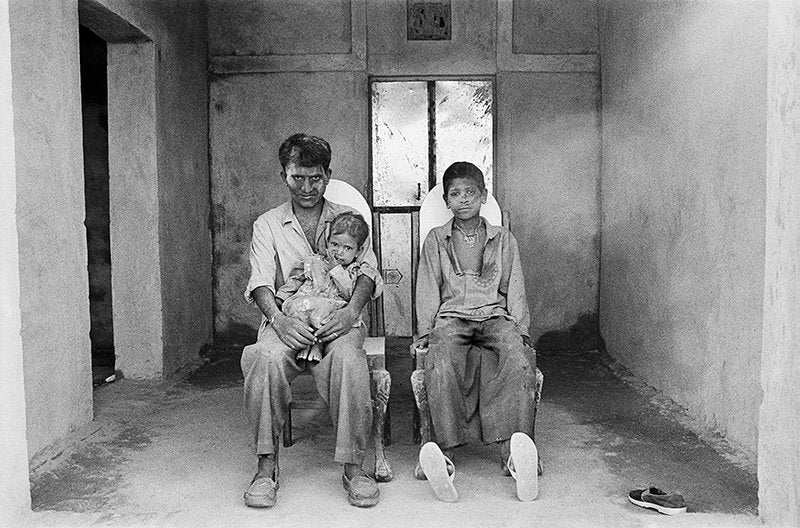
Gauri Gill
Hanuman Nath with his daughter and Hem Nath, on Holi day, Lunkaransar by Gauri Gill
 Toronto, ON)
Toronto, ON)
Learn about our Shipping & Returns policy.
Have a question? Read our FAQ.
- Artwork Info
- About the Artist
- About this Photograph
- Artist Docs
-
1999-2010
Gelatin silver print -
Gauri Gill (b. Chandigarh, India) earned a BFA (Applied Art) from the College of Art, New Delhi; BFA (Photography) from Parsons School of Design/The New School , New York; and MFA (Art) from Stanford University, California. She has exhibited within India and internationally, including MoMA PS1, New York; Documenta 14, Athens and Kassel; Kochi Biennale; 7th Moscow Biennale; Freer and Sackler Galleries at the Smithsonian Institution, Washington; Wiener Library, London; Art Gallery of Ontario, Toronto and Whitechapel Gallery, London. Her work is in the collections of prominent institutions worldwide, including the Museum of Modern Art, New York; Tate Museum, London; the Smithsonian Institution, Washington and Fotomuseum, Winterthur, and in 2011 she was awarded the Grange Prize, Canada’s foremost award for photography.
Gill’s practice is complex because it contains several lines of pursuit. These include an almost two decade long engagement with marginalised communities in rural Rajasthan called Notes from the Desert (since 1999)—this ongoing archive contains sub-series such as The Mark on the Wall, Traces, Birth Series, Jannat, Balika Mela, and Ruined Rainbow. She has explored human displacement and the migrant experience in The Americans and What Remains. Projects such as the 1984 notebooks highlight her sustained belief in collaboration and ‘active listening’, and in using photography as a memory practice. Beginning in early 2013, Fields of Sight is an equal collaboration with the renowned Adivasi artist, Rajesh Vangad, combining the contemporary language of photography with the ancient one of Warli drawing to co-create new narratives. In her most recent body of work, Acts of Appearance, (2015—), the artist has worked closely with the paper mache artists of the Kokna tribe in Maharashtra, using unique masks to tell fictional stories improvised together of contemporary life in the village. Working in both black and white and colour, Gill’s work addresses the twinned Indian identity markers of class and community as determinants of mobility and social behaviour; in it there is empathy, surprise, and a human concern over issues of survival.
Source: Gauri Gill’s website -
The extensive project (begun in 1999) is a photographic archive of the years Gill has spent visiting her friends among marginalised rural communities in Western Rajasthan—including Jogi nomads, Muslim migrants and Bishnoi peasants.
The body of work encompasses various narratives and sub-series within it, and uses different forms of image making. There are photographs structured around performance and portraits—some spontaneous, others created in collaboration with her subjects. It includes posed pictures made in a tent studio on the one hand (Balika Mela); cinema-verite intimate portraits on the other (Birth Series, Jannat); those that are staged in real life environments; or using negatives made and discarded by others (Ruined Rainbow). The work references vernacular and popular practices of photography and image making often found in and around the village—including the studio portrait, passport photo, religious calendar art and Bollywood posters. The archive also contains images without visible persons, yet containing human presence—for instance, documenting drawings in schools in The Mark on the Wall; and both marked and unmarked graves in Traces.
Gauri hopes to eventually publish the work as a series of individual books—each book a note from the desert. The first one, Balika Mela, was published in 2012.
“To set up a photographic project in rural Rajasthan, in black and white, stretching over a decade, goes against the grain of several stereotypes; and signals the maturing of a ‘voice’ within the corpus of Photography in India. Defrocked of its color and tourism potential, Rajasthan, is scoured at the nomadic margins; revealing lives in transition: epic cycles of birth, death, drought, flood, celebration and devastation, through which they pass. The extremity of the situation requires no illustration or pictorialism—those vexed twins of the colonial legacy—especially from an insider, or the one who is led by the hand. Her subjects take her into their world, and she goes there like Alice. Her method embraces ‘Time’—which does not ‘naturally’ exist inside a photograph, beyond the epiphany and commemoration of a moment (photography’s melancholy and limitation is precisely this)—within a structure of intimacy and relationships that unravel their mysteries slowly.”
Excerpted from Anita Dube’s essay: The Desert—Mirror: Reflections on the photographs of Gauri Gill, 2010.
Source: Gauri Gill’s website
-
Artist CV (PDF)
Artist Bio (PDF)


